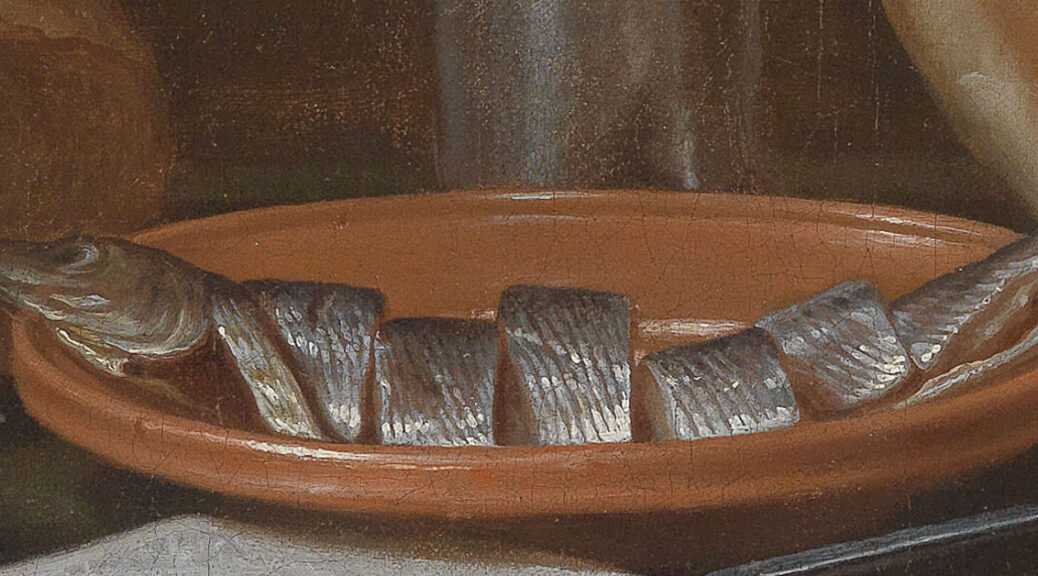Read, hot & digitized: Librarians and the digital scholarship they love — In this new series, librarians from UTL’s Arts, Humanities and Global Studies Engagement Team briefly present, explore and critique existing examples of digital scholarship. Our hope is that these monthly reviews will inspire critical reflection of and future creative contributions to the growing fields of digital scholarship.
“Fishing in the past” encourages us to explore the connections between artistic expression, scientific identification, and commercial practices. A crowdsourced metadata project, “Fishing in the past” asks volunteers to identify fish species represented in Dutch still life paintings from the early modern period to learn more about historical aquatic biodiversity and commercial uses of fish in Europe. The campaign is part of “A new history of fishes,” a project funded by the Dutch Research Council that includes researchers from Leiden University Centre for the Arts in Society and Naturalis Biodiversity Centre. The artwork included in the “Fishing in the past” campaign comes from the Rijksmuseum and the RKD – Netherlands Institute for Art History. The project was designed using Zooniverse, “the world’s largest and most popular platform for people-powered research.”[1] This crowdsourced approach to research has been termed “citizen science.”[2]

This painting from the Rijksmuseum collection is just one example of the artwork included in the Fishing in the past project. Still Life with Fish, Sea Food and Flowers, Clara Peeters, c. 1612 – c. 1615, http://hdl.handle.net/10934/RM0001.COLLECT.5020
I discovered “Fishing in the past” while evaluating Zooniverse for possible use in the creation of a crowdsourced metadata campaign for photographs from the “Sajjad Zaheer Digital Archive.” I was intrigued by the project’s use of art to support scientific research. This is just one example of how digital scholarship tools and methods can facilitate interdisciplinary projects that propose creative solutions to existing research problems. “A new history of fishes” examines the relationship between ichthyology (the study of fish) and European history and culture, an area of inquiry that “has always been underexposed.”[3] Though quite different in subject matter, the “Sajjad Zaheer Photo Archive” and “Fishing in the past” share the objective of identifying beings (human and aquatic, respectively) in images, a belief in the value of opening up research projects to the general public, and a commitment to open access data and information. As such, “Fishing in the past” was a helpful model for my own project.
“Fishing in the past” asks members of the public to identify the species for every fish in an image. The research team provides tools to help, such as a list of common species that includes images and identifying features to assist classification. The species list can filtered by characteristic, such as color or pattern. After identifying the species, contributors are instructed to classify the commercial use of the fish, such as traded at a market or consumed on plate. They finally record the number of fish for a single species in the image. The process is repeated for each species pictured.

The species identification step in the Fishing in the past workflow. The painting shown here is Zeewezens en zeemonsters, Hans Savery, 16(16) (dated) (1616 – 1625), https://rkd.nl/explore/images/29771
The “Fishing in the past” team has already shared some initial results and plans to publish further findings in an open access journal. Through crowdsourcing, this project has generated more data in a shorter period of time than could be achieved by the research team alone. Benefits for volunteers include engaging in their interests, interacting with artistic and scientific materials in new ways, and knowing that they are making a contribution to something bigger than themselves. For future researchers, crowdsourcing campaigns provide valuable data, including the ability to “read” materials with accessibility technologies.
All Zooniverse campaigns can be found here. Those interested in crowdsourced transcription work might also enjoy participating in FromThePage projects from University of Texas Libraries.
The Fine Arts Library holds catalogs that accompanied past Dutch and Flemish still life exhibitions.
Those interested in marine science should start with this LibGuide.
[1] https://www.zooniverse.org/about
[2] For an in-depth look at citizen science: Hecker, S., Haklay, M., Bowser, A., Makuch, Z., Vogel, J., & Bonn, A. (2018). Citizen Science: Innovation in Open Science, Society and Policy. University College London.
[3] https://www.universiteitleiden.nl/en/research/research-projects/humanities/new-history-of-fishes
Madeline Goebel is the Global Studies Digital Projects GRA at Perry-Castañeda Library and a current graduate student at the School of Information.

